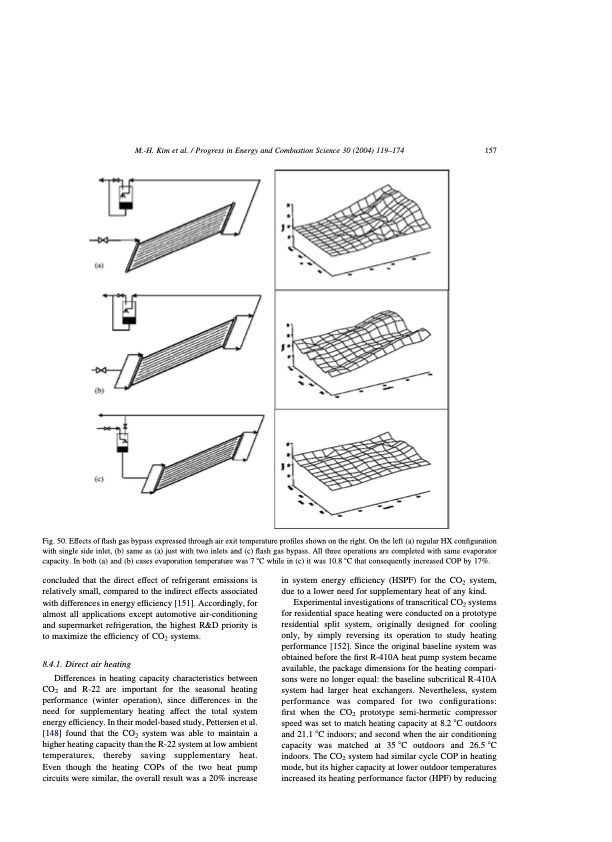
PDF Publication Title:
Text from PDF Page: 039
M.-H. Kim et al. / Progress in Energy and Combustion Science 30 (2004) 119–174 157 Fig. 50. Effects of flash gas bypass expressed through air exit temperature profiles shown on the right. On the left (a) regular HX configuration with single side inlet, (b) same as (a) just with two inlets and (c) flash gas bypass. All three operations are completed with same evaporator capacity. In both (a) and (b) cases evaporation temperature was 7 8C while in (c) it was 10.8 8C that consequently increased COP by 17%. concluded that the direct effect of refrigerant emissions is relatively small, compared to the indirect effects associated with differences in energy efficiency [151]. Accordingly, for almost all applications except automotive air-conditioning and supermarket refrigeration, the highest R&D priority is to maximize the efficiency of CO2 systems. 8.4.1. Direct air heating Differences in heating capacity characteristics between CO2 and R-22 are important for the seasonal heating performance (winter operation), since differences in the need for supplementary heating affect the total system energy efficiency. In their model-based study, Pettersen et al. [148] found that the CO2 system was able to maintain a higher heating capacity than the R-22 system at low ambient temperatures, thereby saving supplementary heat. Even though the heating COPs of the two heat pump circuits were similar, the overall result was a 20% increase in system energy efficiency (HSPF) for the CO2 system, due to a lower need for supplementary heat of any kind. Experimental investigations of transcritical CO2 systems for residential space heating were conducted on a prototype residential split system, originally designed for cooling only, by simply reversing its operation to study heating performance [152]. Since the original baseline system was obtained before the first R-410A heat pump system became available, the package dimensions for the heating compari- sons were no longer equal: the baseline subcritical R-410A system had larger heat exchangers. Nevertheless, system performance was compared for two configurations: first when the CO2 prototype semi-hermetic compressor speed was set to match heating capacity at 8.2 8C outdoors and 21.1 8C indoors; and second when the air conditioning capacity was matched at 35 8C outdoors and 26.5 8C indoors. The CO2 system had similar cycle COP in heating mode, but its higher capacity at lower outdoor temperatures increased its heating performance factor (HPF) by reducingPDF Image | CO2 Vapor Compression Systems

PDF Search Title:
CO2 Vapor Compression SystemsOriginal File Name Searched:
co2-vapor-compression-systems.pdfDIY PDF Search: Google It | Yahoo | Bing
CO2 Organic Rankine Cycle Experimenter Platform The supercritical CO2 phase change system is both a heat pump and organic rankine cycle which can be used for those purposes and as a supercritical extractor for advanced subcritical and supercritical extraction technology. Uses include producing nanoparticles, precious metal CO2 extraction, lithium battery recycling, and other applications... More Info
Heat Pumps CO2 ORC Heat Pump System Platform More Info
| CONTACT TEL: 608-238-6001 Email: greg@infinityturbine.com | RSS | AMP |